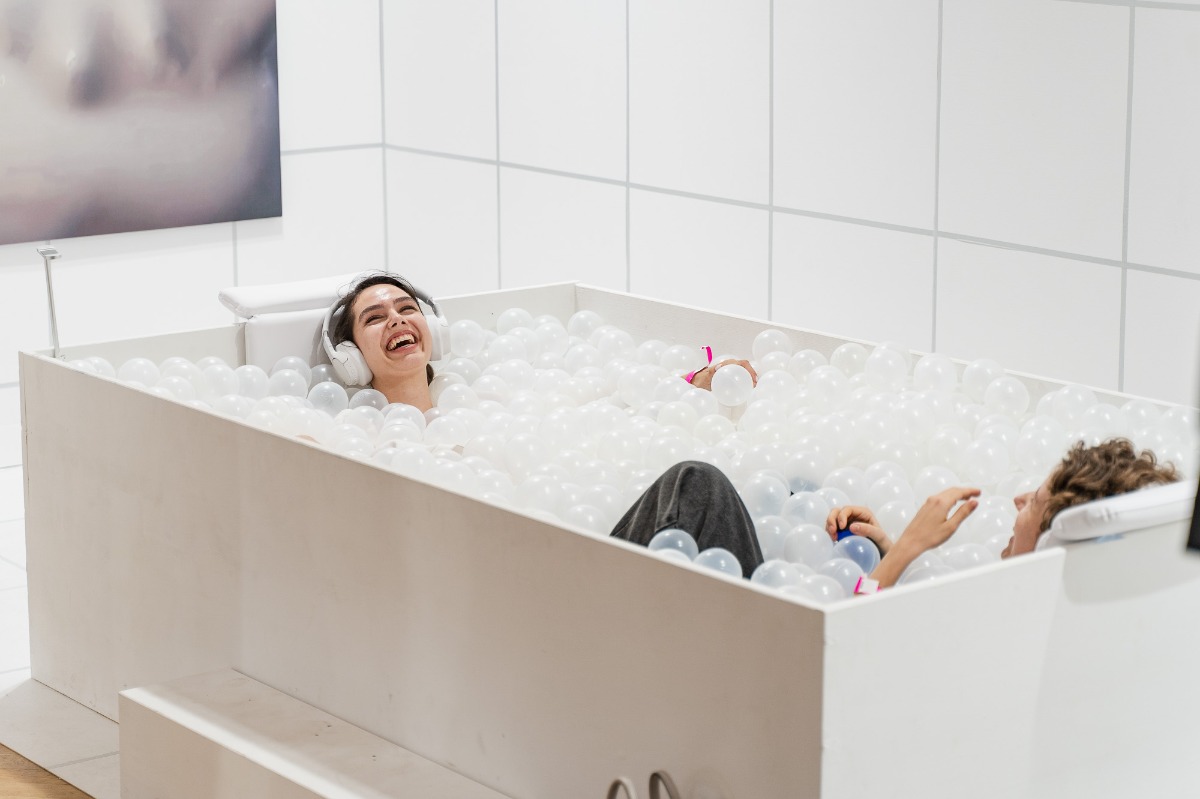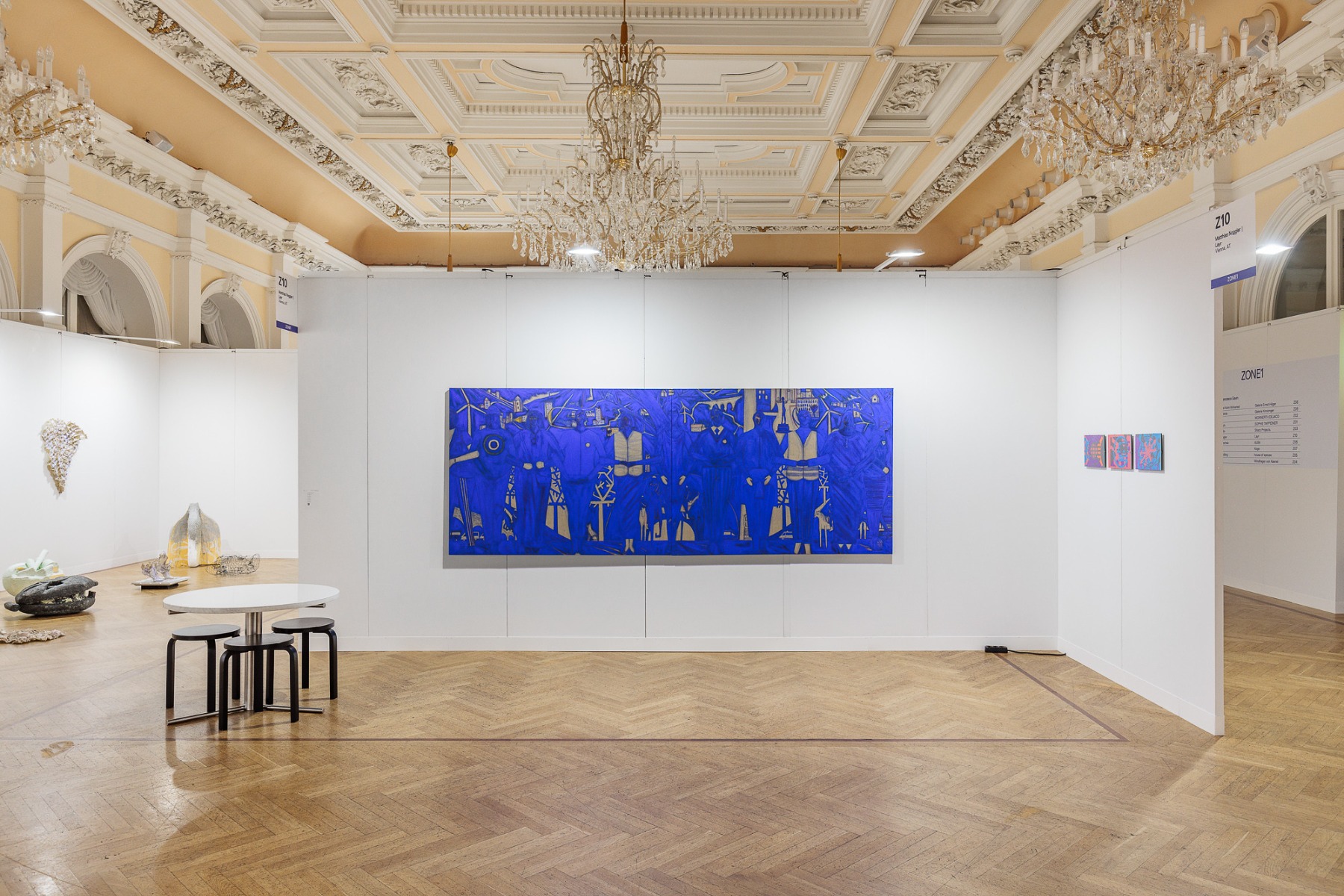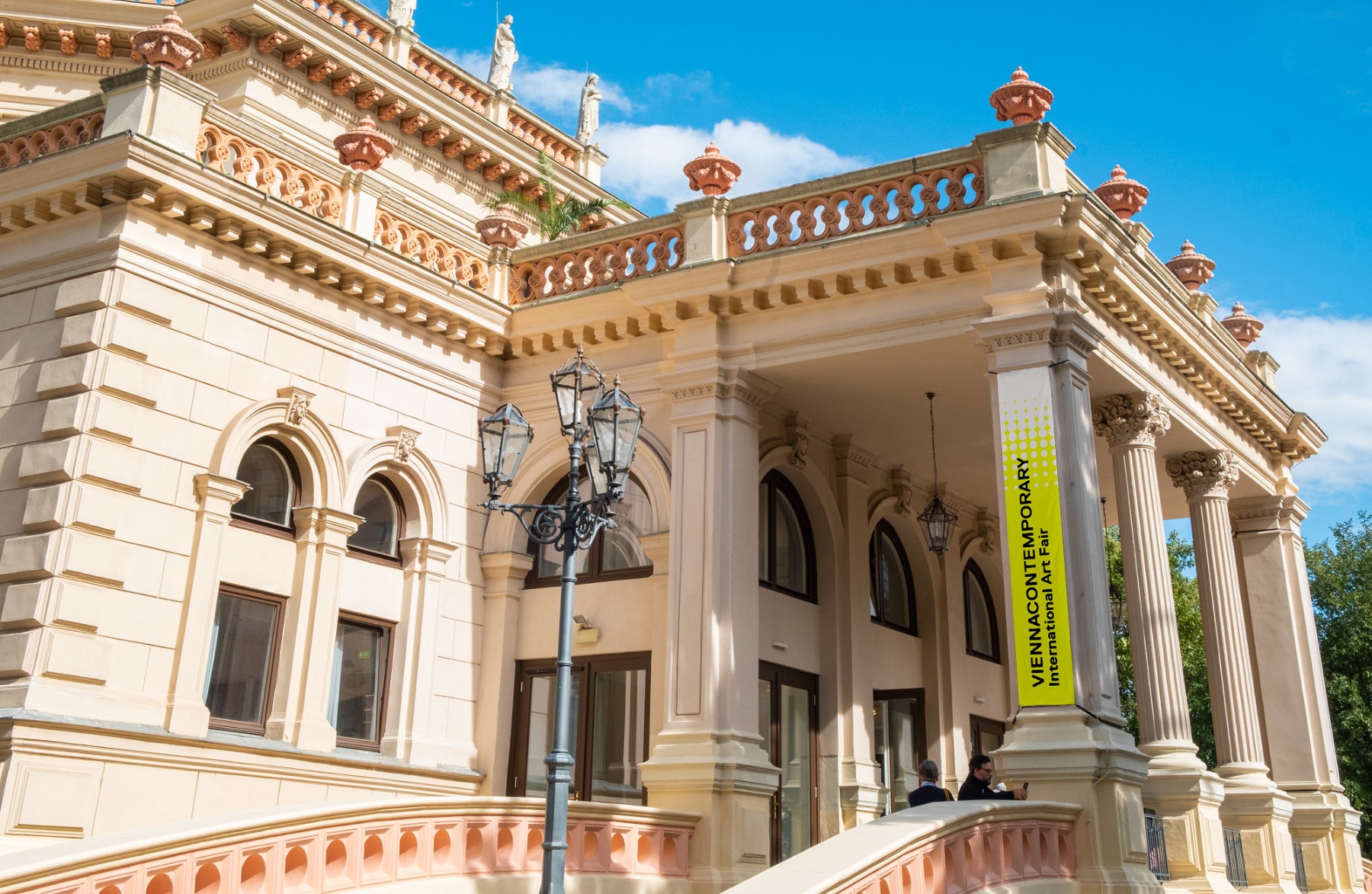
The viennacontemporary art fair 2023 has come to a close
A look back at the 2023 edition of the international contemporary art fair and a glimpse into its future
With the arrival of the autumn art market season, several art fairs in Europe opened their doors in September in cities such as Berlin, Paris and Vienna, the latter being where the international contemporary art fair viennacontemporary 2023, dedicated to Austrian and Central and Eastern European art, took place from September 7 to 10. This year, 62 galleries from 20 countries took part in the fair, giving 150 artists the opportunity to showcase their work to local and international audiences (15 galleries participated for the first time, while several Vienna galleries returned to viennacontemporary after a hiatus of several years).
Galerie Anita Beckers (Frankfurt am Main, Germany) at viennacontemporary 2023. Works by Annegret Soltau and Peter Weibel. Photo: kunst-dokumentation.com
Overall, the fair was in a state of equilibrium ensured not only by the balance of presence between historical institutions and art market newcomers, but also by the arrangement of gallery content created in a dialogue between different genres and media, as well as by juxtaposing historical positions with very fresh and topical content. In the future, Boris Ondreička, the artistic director of viennacontemporary, intends to work more purposefully with the relationship between classical modern, late modern (or neo-avant-garde) and contemporary art, stressing that “it is precisely the dialogue and dynamics that ensure the best result for both parties – the fair and its participants”.
The Naked Room (Kyiv, Ukraine) at viennacontemporary 2023. Works by Lucy Ivanova. Photo: kunst-dokumentation.com
From a “boutique” format to that of a “department store”
While this year’s fair continued the “boutique” format launched last year – a small number of galleries in the luxurious surroundings of Kursalon Vienna – next year’s fair will transform into more of a "department store" format and move to the spacious premises of the Messe Wien exhibition centre. The fact that the fair might have changed its plans for the Kursalon was indicated by the unexpected changes in the layout of the special ZONE1 programme. Despite the fact that only last year viennacontemporary’s artistic director Boris Ondreička had stated his plans to invest in and renovate the basement, this year it remained closed to visitors and ZONE1 was moved three floors up.
This change regarding the fair’s future location can be justified on several levels – it’s a strategic decision with the aim of providing more space and more opportunity for a larger number of participants, and it will ensure adequate logistics. Although the original location of the fair in the historic centre of Vienna – a calculated choice that gave people the "hardcore Vienna" experience (i.e. an authentic 19th-century-postcard-depiction of the city) alongside their visit to the fair – was well intended, the building proved to be logistically unsuitable for the needs of the fair. As it turned out, the basement was too claustrophobic for last year’s fair participants, and the task of moving and positioning the artworks among the three floors of the Kursalon was simply too complicated.
As an aside, the layout and art wall build-up service for this year’s viennacontemporary exhibition was provided by the Latvian company Art Fairs Service; the firm has been operating since 2014 and currently provides construction services using Latvian-made modular systems for around 40 exhibitions per year (including VOLTA Basel, Art on Paper Brussels, Affordable Art Fair Brussels, Photo Basel, Positions Berlin, etc.). In the context of viennacontemporary, Kaspars Auželis, CEO of the company, emphasises that the equipment provided by Art Fairs Service is particularly suitable for historic buildings such as Kursalon Vienna because the structures are completely autonomous (nothing is fixed to the walls or ceilings) and are installed with respect for the elements of the space that must be protected.
Galerie Elisabeth & Klaus Thoman (Innsbruck/Vienna, Austria) at viennacontemporary 2023. Work by Peter Sandbichler. Photo: kunst-dokumentation.com
The move to Messe Wien, where viennacontemporary (formerly known as Vienna Fair) was held until 2014, is seen by Managing Director Markus Huber as not only a strategic necessity, but also a great opportunity. “The fair will no longer take place in Hall 8 as in the past, but in Hall D, designed by Austrian architect Gustav Peichl to be the design hall of the exhibition centre. In addition, the area around Messe Wien has changed rapidly in recent years – what was once a sad and cynical landscape of illicit prostitution has now been replaced by a gentrified ‘hipster’ neighbourhood.”
VR artwork “The Fetch” by Christiane Peschek. VCT Activation program curated by Francesca Gavin. Photo: Matthias Jaidl
New Stakeholders, New Horizons: politics and tech unite for internationalization
At least 100 galleries are expected to participate in the next edition of the fair. Some good news that Huber shares is the long-hoped-for and finally achieved cooperation with the Association of Austrian Galleries (AAG) – AAG is now committed to recognizing that Vienna needs an international art fair, and that that fair will be viennacontemporary. “Vienna has a relatively large cultural budget compared to other cities, but 95% of it is dedicated to the performing arts, while our sector is underfunded. This is because the city’s classical reputation has been built upon opera, music and theatre.”
Meno Parkas Gallery (Kaunas, Lithuania) at viennacontemporary 2023. Works by Elena Balsiukaitė-Brazdžiūniene, Kęstutis Zapkus and Egle Ulčickaitė. Photo: Agnese Čivle
For the fair to develop, it needs to become more international. “Internationalization” was also a prominent term that the fair organisers repeatedly emphasised in their promotion for this edition of the fair. It should be noted that this year the proportion of international galleries to Austrian galleries was 56% to 44%; moreover, only two galleries from the Baltic States participated in this fair dedicated to Central and Eastern European art: Meno Parkas (Lithuania) and Kogo (Estonia). It seemed appropriate to ask how the presence of Baltic art at the fair was to be promoted in the future, to which Huber pointed out that further, more visible representation of the region could be facilitated by viennacontemporary’s new collaboration with the American multinational technology conglomerate Meta Platforms Inc. This collaboration marks the beginning of a new alliance aimed at delving into the innovative possibilities of new technologies in the field of contemporary art. The ambition of the organisers of viennacontemporary for presenting a comprehensive and integrative fair goes hand in hand with Meta’s efforts to marry technology with creative expression – to give space for co-creation and collaboration, and as Huber accents, “Meta is also passionate about the diversity of cultural DNAs”. This means that Baltic artists working with new technologies can look forward to some special collaborations in the future. “Having the voice of Baltic art here is a vital necessity!”, Huber emphasises.
The special exhibition ZONE1, curated by British curator Francesca Gavin. Photo: Agnese Čivle
ZONE1. Sensitivity over didacticism
Since 2015, the specially curated ZONE1 exhibition – for which artists under the age of 40 who have lived, worked or studied in Austria are selected – has been a special programme of the fair. Last year, the exhibition curated by the young and progressive Slovenian curator Tjaša Pogačar, juxtaposed with the glossy sheen of the upper floors, was housed in the Kursalon’s rather shabby basement. This year, however, under the wing of British curator Francesca Gavin, ZONE1 was located under the ornate chandelier of the upper floor.
When asked about the guidelines for the selection of artists, Gavin stressed that the ten young artists brought together in ZONE1 are not united by a particular choice of media or subject matter, but by their approach to nuance. "What I find most interesting about the work of these artists is that whether their message is about feminism, the challenges of black people, immigration issues or mental health, none of it is presented in a didactic way but with much more sensitivity. This generation of artists bases everything on their personal experience. There is a strong balance between the personal and the conceptual."
The ten ZONE1 participants have varied backgrounds and represent a myriad of ethnicities; currently they all are active in the Austrian contemporary art process. The artists included in the ZONE1 programme represented both prominent and established Viennese institutions (e.g. Galerie Ernst Hilger and Galerie Krinzinger) as well as newcomers to the Austrian art market (e.g. Sophie Tappeiner and Layr).
Laura Põld | Kogo, ZONE1, viennacontemporary 2023. Photo: kunst-dokumentation.com
Alongside them, Kogo Gallery from Tartu, Estonia, presented Ways of Being, an installation by Laura Põld, an Estonian artist who studied in Linz, Austria, and whose latest ceramic works were recently created during her residency at the historic Gmundner Keramik Manufaktur in Upper Austria. Juxtaposed with the exhibit’s white walls, the artist’s nature-inspired ceramic formations and man-made organic shapes and textures appear as if they were living shards torn from the fabric of flora.
Christiane Peschek | Alba, ZONE1, viennacontemporary 2023. Photo: kunst-dokumentation.com
As an aesthetic and conceptual “contrast shower”, Põld’s works were placed adjacent to the stand of artist Christiane Peschek (Galerie Alba, Vienna), which consisted of an installation of cold bathroom tiles and plastic bath foam. Peschek, who also presented a separately curated virtual reality work at the fair, conceived it as a meditative work between physical and virtual reality, complemented by abstract self-portrait images of digital identity on silk.
Anthony Olubunmi Akinbola | Galerie Krinzinger, ZONE1, viennacontemporary 2023. Photo: kunst-dokumentation.com
Under the auspices of Galerie Krinzinger (Vienna), ZONE1 featured first-generation Nigerian-American artist Anthony Akinbola. Similar to the popular American game show “Let’s Make a Deal” hosted by Monty Hall, the artist gives visitors the opportunity to open one of the many doors of a locker, behind some of which is a prize that the visitor can keep – various objects chosen by the artist. The artist emphasises the emotional connection aspect, i.e. the meaning people attach to these objects they’ve “won”, while the curator underlines the coquetry of this work with the concept of an art fair.
Matthias Noggler | Layr, ZONE1, viennacontemporary 2023. Photo: kunst-dokumentation.com
Just around the corner was the presentation of the only white male artist included in the ZONE1 programme (a deliberate choice by the curator!). It was a work by Matthias Noggler (Layr gallery, Vienna) in a combination of blues and browns which at first may appear as an abstract painting, but on closer inspection reveals human figures during a political protest.
Irina Lotarevich | Sophie Tappeiner, ZONE1, viennacontemporary 2023. Photo: kunst-dokumentation.com
Works by Irina Lotarevich (Galerie Sophie Tappeiner, Vienna) are also currently on view at Vienna’s contemporary art museum Belvedere 21, in the exhibition On the New. Viennese Scenes and Beyond – Part 2, which, like ZONE1, provides an insight into the emerging artists of the Austrian contemporary art scene. Lotarevich’s roots lie in Russia, from where she emigrated to America and later, studied in Vienna. Her sculptural works are designed as self-portraits consisting of hand prints and skin textures – they tell the story of identity as represented in the endless bureaucratic documentation that invariably accompanies the immigrant.
Brishty Alam | Wonnerth Dejaco, ZONE1, viennacontemporary 2023. Photo: kunst-dokumentation.com
Brishty Alam (Wonnerth Dejaco gallery, Vienna) is another artist selected for ZONE1 by curator Francesca Gavin and whose work is also currently on show at the contemporary art museum Belvedere 21. The artist studied organic chemistry at Cambridge and much of her work lies at the intersection of science, biology and art. In her kinetic fish sculptures carved from polystyrene foam, she experiments with form, movement and materiality while embracing a significant cross-cultural message.
Elisabeth Molin | Sharp Projects, ZONE1, viennacontemporary 2023. Photo: kunst-dolumentation.com
Elisabeth Molin (Sharp Projects gallery, Copenhagen) surprises with her aluminum casts of the shadows of Disney characters.
Julia Znoj | Windhager von Kaenel ZONE1, viennacontemporary 2023. Photo: kunst-dokumentation.com
Julia Znoj (Windhager von Kaenel, Zug, Switzerland) is inspired by ideas about the 19th-century female body and death. It is no coincidence that the artist’s works, whose raw materials include metal, plastic, paper, sugar and various found objects, have a certain haunting quality.
Katharina Schilling | house of spouse, ZONE1, viennacontemporary 2023. Photo: kunst-dokumentation.com
Katharina Schilling (house of spouse Galerie, Vienna) broadens the notion of painting. Sometimes bordering on photorealism, the technically nuanced works remove objects and motifs from their historical context and give them new meanings.
Assunta Abdel Azim Mohamed | Galerie Ernst Hilger, ZONE1, viennacontemporary 2023. Photo: kunst-dokumentation.com
Assunta Abdel Azim Mohamed (Galerie Ernst Hilger, Vienna) creates works in a dense visual language using the time-consuming ballpoint-pen technique. The artist creates surreal environments and scenarios in which she satirically integrates images from her own generation. The central work of the stand is interesting – the artist has created a transformable sculpture that allows the viewer to project an image of their digital identity, made up of prototypes or digital figures such as “activist”, “influencer” or “internet addict”, the latter spending his life on Reddit, thus becoming basically celibate and never having any real contact with a live partner.
The ZONE1 programme is perhaps the greatest added value of the fair, providing an insight into the most current Austrian artistic processes created by young artists of all ethnic backgrounds, and further promoted by two important centres of art education in Austria: the Academy of Fine Arts Vienna and the University of Applied Arts Vienna. The network of artist-run non-commercial and independent contemporary art spaces (“off-spaces”) in Vienna is also an important contributor to this scene, allowing new artistic currents to become more visible.
viennacontemporary at Kursalon Wien. Photo: Maria Belova
Meanwhile, the history of viennacontemporary is witnessing yet another attempt to raise the bar in terms of quality. With what is by no means the first announcement of a new chapter, a new era or a new beginning for viennacontemporary – historically encompassed by both structural changes at the core of the fair and yet another change of venue – the fair’s artistic director Boris Ondreička determinedly says, “Let’s make viennacontemporary great again!”
Let’s make it happen!
Title image: ZONE1 at viennacontemporary 2023 by curator Francesca Gavin, Kursalon Wien. Photo: kunst-dokumentation.com